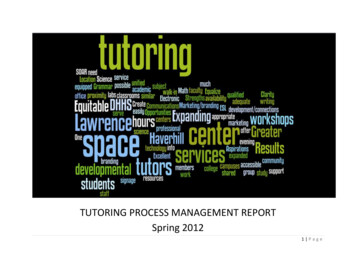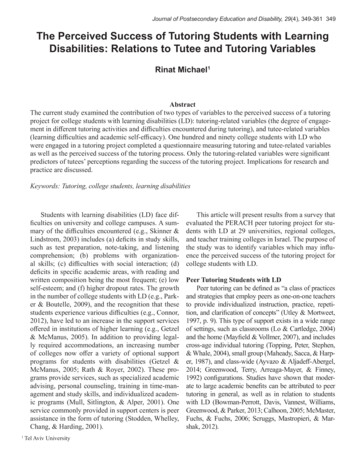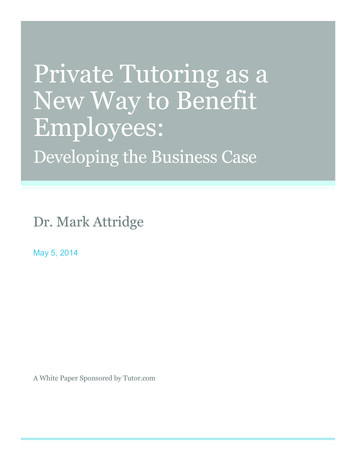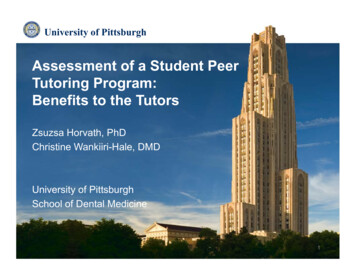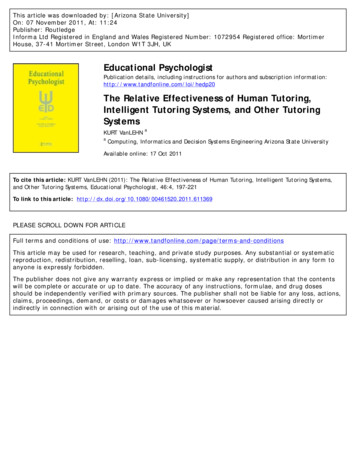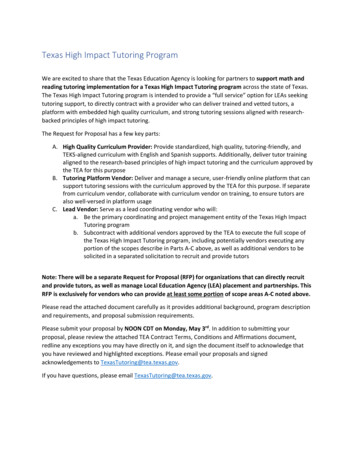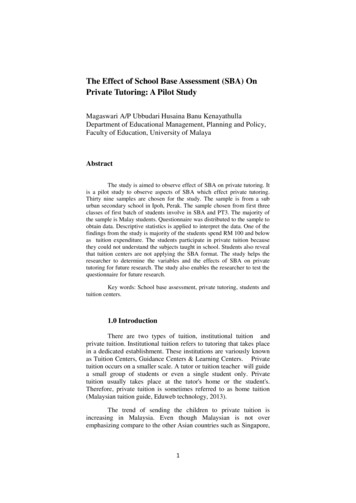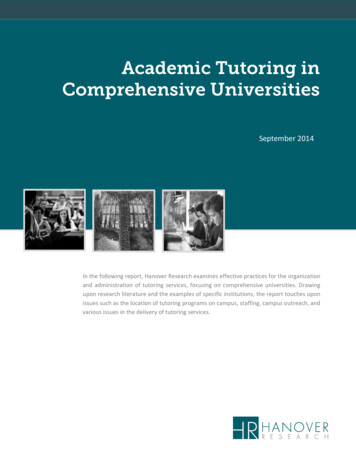
Transcription
Academic Tutoring inComprehensive UniversitiesSeptember 2014In the following report, Hanover Research examines effective practices for the organizationand administration of tutoring services, focusing on comprehensive universities. Drawingupon research literature and the examples of specific institutions, the report touches uponissues such as the location of tutoring programs on campus, staffing, campus outreach, andvarious issues in the delivery of tutoring services.
Hanover Research September 2014TABLE OF CONTENTSExecutive Summary and Key Findings . 3INTRODUCTION . 3KEY FINDINGS . 4Issues in Academic Tutoring . 6ORGANIZATION OF TUTORING SERVICES . 6Using the Library as a Site for Tutoring Services . 8STAFFING OF TUTORING SERVICES. 9Selecting and Training Peer Tutors . 10Supplemental Instruction . 11OUTREACH FOR TUTORING SERVICES . 13DELIVERY OF TUTORING SERVICES . 14Individual or Group Tutoring . 14Scheduling Arrangements. 15Online Tutoring . 16 2014 Hanover Research Academy Administration Practice2
Hanover Research September 2014EXECUTIVE SUMMARY AND KEY FINDINGSINTRODUCTIONMost college campuses offer academic tutoring services to some degree, often through alearning assistance center that may offer a range of related services.1 Learning assistancecenters and the academic tutoring services they provide play an important role insupporting student success, and have been associated with positive student outcomes, suchas improved grades and retention rates.2Over the past several decades, learning assistance has emerged as a distinct element ofhigher education, with increasing attention paid to the effective organization andadministration of these services.3 However, learning assistance centers and related unitscontinue to develop as colleges and universities seek to leverage best practices forintegrating these functions into the institution.4Some of the major issues facing learning assistance centers and tutoring services include:5 Organization: Learning assistance functions may or may not be housed in acentralized office on campus, and may encompass a more or less broad scope ofservices, from study skills to writing and math assistance to content‐specifictutoring. Regardless, it is important that learning assistance be integrated with therest of the institution and have support from the central administration. Staffing: A “trained and caring staff” is critical for providing learning assistance, andtutoring staff may include peers as well as professionals.6 Training and professional1Dvorak, J. “Managing Tutoring Aspects of the Learning Assistance Center.” Research for Educational Reform.December 2004. p. 39. tance‐center2[1] Bettinger, E. “Student Supports: Developmental Education and Other Academic Programs.” The Future ofChildren. Spring 2013. pp. 101, dren/publications/docs/23 01 05.pdf[2] Hendriksen, S. et al. “Assessing Academic Support: The Effects of Tutoring on Student Learning Outcomes.”Journal of College Reading and Learning. Spring 2005. pp. 60‐61. http://eric.ed.gov/?id EJ689654[3] Perin, D. “Remediation Beyond Developmental Education: The Use of Learning Assistance Centers to IncreaseAcademic Preparedness in Community Colleges.” Community College Journal of Research and Practice. August2004. http://eric.ed.gov/?id EJ6822403Arendale, D. “Mainstreamed Academic Assistance and Enrichment for All Students: The Historical Origins of LearningAssistance Centers.” Research for Educational Reform. December 2004. pp. 13‐17.http://www.tc.umn.edu/ arend011/HistoryLAC.pdf4D’Adamo‐Weinstein, L. “Best Practices in Learning Center Management.” NCLCA Institute. July 2010. Slides 2, 9‐10.http://nclcainstitute2010.pbworks.com/f/LDW ‐ Best Practices in Managing Your Learning Center Effectively.pptx5Unless otherwise cited, bulleted points draw upon: Landsberger, J. “Learning by Design: An Interview with FrankChrist.” TechTrends. Sept./Oct. 2007. p. 6. 007‐0060‐66Wilson, W. and Arendale, D. “Peer Educators in Learning Assistance Programs: Best Practices for New Programs.”New Directions for Student Services. Spring 2011. http://eric.ed.gov/?id EJ921046 2014 Hanover Research Academy Administration Practice3
Hanover Research September 2014development are also critical, and various forms of certification for tutoring staff canbe used to ensure program quality.7 Outreach: Whether students are referred by faculty or “self‐referred,” theavailability of tutoring services should be communicated effectively through“ongoing publicity and public relations activities.” Delivery: Learning assistance may be delivered in various forms, whether to groupsor to individuals, in‐person by appointment or walk‐in, or through the use oftechnology such as online tutoring. Each of these forms of delivery has drawbacksand advantages that must be considered when implementing these services.This report examines effective practices in these areas, based on research literature and theexperience of individual institutions, with a focus on mid‐sized, comprehensive universities.An accompanying spreadsheet details basic characteristics about the programs reviewed forthis report.KEY FINDINGS7 Tutoring services may be more effectively delivered through a centralizedadministrative unit. Bowling Green State University, for instance, has seenimprovements in the accessibility, efficiency, and accountability of its tutoringservices after consolidating the writing center, study skills tutoring, and mathtutoring in a single “Learning Commons.” Several other institutions reviewed for thisreport have taken similar steps in recent years. Experts suggest that, at a minimum,there should be some coordination between various learning assistance servicessuch as the writing center, math tutoring, and tutoring in other subjects. The placement of tutoring services in a central campus location can increaseaccess and visibility. The campus library, in particular, has been chosen by multipleinstitutions reviewed for this report as an optimal location for tutoring servicesbecause of its academic environment, high student traffic, and proximity to learningresources. Central Washington University, Bowling Green State University, andWestern Washington University, for instance, have all seen increased utilizationsince placing tutoring services in the library. Most colleges and universities use peer tutors to provide tutoring services. The useof peer tutors is “common throughout the academy,” and is found at most of theinstitutions reviewed for this report. Many institutions use formal training programs,such as College Reading and Learning Association tutor certification training, toensure the quality of tutoring provided by student employees. Tutoring programs should strive for high visibility on campus. Outreach initiativesensure that faculty and other campus constituents, as well as students, are aware ofCalderwood, B. “Learning Center Issues, Then and Now: An Interview with Frank Christ.” Journal of DevelopmentalEducation. Spring 2009. p. 26. http://eric.ed.gov/?id EJ868670 2014 Hanover Research Academy Administration Practice4
Hanover Research September 2014the range of tutoring services available and can refer students to them asappropriate. Tutoring can be effective in a drop‐in or appointment‐based setting. Someinstitutions encourage students to participate in regular, recurring tutoring sessions,which is the traditional model and is recognized as effective in improving studentlearning. However, evidence suggests that drop‐in, or walk‐in, tutoring can alsosupport student learning. Most of the institutions reviewed for this report offer bothtypes of scheduling. Online tutoring is growing in prevalence. Online tutoring can take various forms,from the use of remote technologies (e.g., Skype) to conduct tutoring sessions to theuse of third‐party providers such as eTutoring.org or Tutor.com. A number of theinstitutions reviewed for this report offer online tutoring, but the practice is notuniversal. 2014 Hanover Research Academy Administration Practice5
Hanover Research September 2014ISSUES IN ACADEMIC TUTORINGORGANIZATION OF TUTORING SERVICESThe organization of learning assistance services varies from institution to institution. Thesefunctions may come under the purview of academic affairs, student affairs, or some otherdivision, such as enrollment management. At least one researcher suggests that “the mosteffective and strategic location for learning assistance” is “at the crossroads” of academicaffairs, student affairs, and enrollment management.8 However, Frank Christ, a leadingauthority on learning assistance,9 has suggested that placement of these services underacademic affairs is more natural and helps to develop faculty awareness of “what thelearning assistance center [does] as an academic support service.”10Perhaps the most pressing question oforganization is whether tutoring services will beMany institutions are choosing tocentralized in a single office or distributedconsolidate tutoring services in aacross multiple units. Both centralized andsingleadministrative unit, or at leastdecentralized models of learning assistance canto place them in a single, commonbe found in higher education institutions,11 andlocation.this pattern is evident among the institutionsreviewed for this report. A number of theseinstitutions operate independent units foracademic skills, writing or math assistance, or content tutoring, while others gather thesefunctions into a single center.Some evidence suggests that the centralized model is more effective than the decentralizedone. In the related context of developmental education, for instance, research hasestablished that the organization of “all [remedial] courses and services . . . under a singleadministrative unit with its own director” leads to better student outcomes than offeringthese services through individual academic departments.12 Similarly, a study comparing thepractices of tutors working in a centralized learning assistance center with those of tutorsworking for individual departments found that the former generally employed moreeffective tutoring strategies.13 Frank Christ suggests that, even if “separate centers” aremaintained for different types of tutoring, such as “science, math, writing, and individualcourse assistance,” some centralized organization should be imposed on these units by8Arendale, D. “Access at the Crossroads: Learning Assistance in Higher Education.” ASHE Higher Education Report.2010. http://eric.ed.gov/?id EJ8870789“Frank L. Christ, Advocate of Learning Assistance, Dies at 89.” Chronicle of Higher Education. January 21, st‐Advocate‐of/136739/10Landsberger, J. “Learning by Design: An Interview with Frank Christ.” Op. cit., p. 7.11Arendale, D. “Access at the Crossroads.” Op. cit.12Boylan, H. et al. “Program Components and Their Relationship to Student Performance.” Journal of DevelopmentalEducation. Spring 1997. p. 3. s.pdf13Bailey, G. “Tutoring Strategies: A Case Study Comparing Learning Center Tutors and Academic Department Tutors.”University of North Carolina‐Greensboro. 2010. pp. 2‐3, 179, ey Geoff/Bailey Geoffrey dissertation 4‐7‐10.pdf 2014 Hanover Research Academy Administration Practice6
Hanover Research September 2014linking them “to [the campus learning center] and to each other through [a roundtable] orto a similar campus structure that would promote communication on a scheduled basis.”14Several of the institutions reviewed for this report have moved toward a more centralizedmodel of tutoring services in recent years, including Bowling Green State University, CentralWashington University, and Saginaw Valley State University.Bowling Green State University provides an example of an institution that has recentlymoved to consolidate its learning assistance services in a centralized hub. In 2009, as part ofa broader strategic planning process, the University undertook a review of its tutoringservices, which at the time “consisted of three units . . . each with separate organizationaland operational structures,” including a writing center, a study skills center, and a math andstatistics tutoring center. All three were overseen by an assistant vice president under thevice president for enrollment management. 15 Driven by several considerations, theUniversity elected to consolidate these units in a single entity, the Learning Commons, witha single director who would report to the vice president for enrollment management. Theseconsiderations included:16 Accessibility: The separate learning centers “were in separate locations . . . alllacking a psycho‐social environment that encouraged engagement.” By movingthese services to one location, Bowling Green State sought to create a “single,accessible location for one‐stop support and supplemental intervention.” Cost‐Effectiveness: Consolidation would allow for more efficient management and a“less‐cost‐per‐student model,” both by reducing overhead and creating economiesof scale, but also by allowing for unified planning to meet challenges such asincreased service demands. Accountability: Finally, a centralized organization would allow for consistenttracking of student usage and outcomes, versus the fragmented approaches of theindependent units, which used “variable measures and methodologies.”For instance, cost‐savings were achieved through the elimination of several positions as theold tutoring centers were consolidated and former employees either took early retirementor moved to new positions within the University. In turn, these savings allowed for anexpansion of services, as funds were “internally reallocated” to create positions for a full‐time director and a tutor coordinator, who would “expand the number and variety ofsubjects offered.”17 This “subject‐area tutoring” essentially constitutes a fourth functionthat exists alongside the three original services of study skills, writing, and math support.18To improve accountability, Bowling Green State’s new Learning Commons addresses “one ofthe problems with having decentralized tutoring centers,” namely the “lack of consistent,14Landsberger, J. “Learning by Design: An Interview with Frank Christ.” Op. cit., p. 7.“HLC Quality Initiative Report: A Learning Commons.” Bowling Green State University. August 31, 2012. p. itReport.pdf16Ibid., pp. 3‐4.17Ibid., p. 5.18Ibid., p. 4.15 2014 Hanover Research Academy Administration Practice7
Hanover Research September 2014accurate, and appropriate data.”19 As part of the reorganization, the University purchasedAccudemia, a “web‐based academic center management system” that tracks student visitsand other metrics.20 The software allows Bowling Green State to see, for instance, howmany upperclassmen use the tutoring services; which majors account for the most studentsseeking tutoring; and whether students with high GPAs use the services in addition to thosewho are struggling. Ultimately, the University should be able to “pre‐allocate personnel inanticipation of projected demands for future semesters.”21USING THE LIBRARY AS A SITE FOR TUTORING SERVICESIn order to improve the accessibility of its learning assistance services, Bowling Green Statealso took a step that appears to have become increasingly common in recent years, namelyplacing tutoring and related services in the library. Hosting academic tutoring in the libraryis a common approach,22 and while not all of the institutions reviewed for this report followthis practice, a considerable number do, including multiple institutions that have recentlyrelocated tutoring to the library as part of broader reorganization, such as: Bridgewater State University: At Bridgewater State, the Academic AchievementCenter, which hosts multiple support services, including tutoring, is housed in “9,000square feet on the ground floor of the library.” This space was established in 2001 toreplace a more fragmented arrangement that “provid[ed] little opportunity forcollaboration and discussion between the personnel who provided the services.”23 Central Washington University: In early 2013, Central Washington Universityrelocated its writing center, math center, and tutoring program to a commonlocation in the first floor of the main library in order to provide “comprehensiveacademic support services . . . in one location.”24 Now known as the LearningCommons,25 the Central Washington programs have seen an increase in utilizationsince moving to the library, at least partly because of their increased “visibility andeasier access.”26 Saginaw Valley State University: Saginaw Valley State created its current Center forAcademic Achievement in 2012, “when separate tutoring services were consolidated19Ibid., p. 6.“Accudemia – Academic Center Management in the Cloud.” Engineerica. http://www.engineerica.com/accudemia21“HLC Quality Initiative Report: A Learning Commons.” Bowling Green State University. Op. cit., pp. 6‐10.22Landsberger, J. “Learning by Design: An Interview with Frank Christ.” Op. cit., p. 7.23Bukowiecki, E. et al. “A Center for Academic Achievement: How Innovative Collaborations Between Faculty andLearning Center Administrators Build Model Credit‐Bearing, First‐Year Courses with Embedded Support for At‐RiskStudents.” International Journal of Learning. 2008. pp. article 1004&context elem ed fac24“CWU Provides Better Access to Student Support Programs.” Central Washington University. January 4, access‐student‐support‐programs25“Welcome to the Learning Commons.” Central Washington University. s and Activities Fee Committee – Minutes.” Central Washington University. April 9, 2014. p. nutes%20April%209,%202014.pdf20 2014 Hanover Research Academy Administration Practice8
Hanover Research September 2014into one physical location in the main campus library.”27 Prior to this move, thetutoring services had been “spread out across campus in distinct centers, which wasconfusing to students”; consolidation in the library was expected to “improveaccess.”28 The University Writing Center continues to operate independently of theother tutoring services,29 but was also relocated to the main library, “making thisbuilding a center of student learning support.”30 Western Washington University: In 2011, Western Washington created a LearningCommons in the main campus library,31 which “brings together resources andprograms to advance teaching and learning,” including the Tutoring Center and theWriting Center.32 Although these units remain administratively independent,33 the“more visible location” in the library contributed to “an increase of over 35 percentin the number of drop‐in tutoring visits” in the first two years.34 Usage has continuedto increase since then.35Bowling Green State followed a model similar to these institutions. The new, consolidatedLearning Commons unit was housed on the first floor of the main library, to “encourageincreased activity in a space on campus with a strong academic climate.”36 It was hoped thatthe location of the Learning Commons in the library would promote “an increase in traffic”to the library, as well as “increased use of the Learning Commons by students who visit thelibrary.” This decision appears to have been successful; in its first year of hosting theLearning Commons, the library gate count increased by 23 percent.37 To facilitate thesharing of space by the two units, the Learning Commons and the library drafted amemorandum of understanding, outlining agreements on how patrons would use therespective spaces, how materials and other resources would be shared, and otheradministrative issues.38STAFFING OF TUTORING SERVICESMost institutions use some combination of peer tutors and professional staff to providelearning assistance services. However, the frontline tutors in most cases are likely to be27“A Self‐Study Report.” Saginaw Valley State University. 2013. p. tudyFINAL021014.pdf28Ibid., p. 121.29See “The Writing Center at Zahnow Library.” Saginaw Valley State University. http://www.svsu.edu/writingcenter/30“A Self‐Study Report.” Saginaw Valley State University. Op. cit., p. 98.31“Strategic Planning Matrix: 2013‐2015 Resource Plan.” Western Washington University. p. infrastructure.pdf32“Learning Commons.” Western Washington University. http://library.wwu.edu/learning commons33See [1] “Western Libraries Organizational Chart.” Western Washington University. February 27, .edu/files/lib org chart current.pdf[2] “Academic and Career Development Services.” Western Washington University. http://www.wwu.edu/acds/34“Strategic Planning Matrix: 2013‐2015 Resource Plan.” Western Washington University. Op. cit.35“Budget Proposal Narrative – Division: Enrollment and Student Services.” Western Washington University. January10, 2014. p. 4. tudentsuccessTOPOST.pdf36“HLC Quality Initiative Report: A Learning Commons.” Bowling Green State University. Op. cit., pp. 3‐4.37Ibid., p. 14.38Ibid., p. 15. 2014 Hanover Research Academy Administration Practice9
Hanover Research September 2014students, whether undergraduates or graduate assistants.39 Saginaw Valley State University,for instance, uses some professional tutors and “select faculty members” to providetutoring,40 but “most tutoring . . . is delivered through the model – common throughout theacademy – of peer‐tutoring.”41Despite this reliance on peers to serve as tutors,some number of professional staff areMost academic tutoring is likely to be“essential,” both to coordinate services and toperformed by other students,oversee the student staff, including thewhether fellow undergraduates orprovision of “ongoing mentoring andgraduate assistants.development” for the peer tutors themselves.42As Saginaw Valley State, for instance,professional faculty and staff run the tutoring and writing centers and “hire, train, evaluate,and provide development opportunities for qualified student tutors.”43SELECTING AND TRAINING PEER TUTORSThe selection of peer tutors follows a fairly similar pattern at most institutions. The typicalprocedure is to advertise openings for tutors and ask students to complete a basicapplication; referrals from faculty may be also be solicited. One of the main qualifications isoften completion (with a grade of B or higher) of the course for which the student will betutoring. Applicants may also be interviewed or asked to conduct a mock tutoring session.44The tutor application form for Saginaw Valley State University, reproduced in Figure 1,shows a characteristic example of such requirements.For peer tutors, some form of training is necessary, as these students are “neitherprofessional educators nor student development specialists.”45 Most of the institutionsreviewed for this report require tutors to undergo training.46 Perhaps the most widelyrecognized peer tutor training program is the College Reading and Learning Association’s(CRLA) International Tutor Training Program Certification, which has been in place since1989 and is “widely used across the country to set professional standards and to verifycollege tutoring program credentials.”47 The CRLA grants certification to programs, ratherthan individuals;48 in turn, a certified program can train individual tutors and certify them at39Dvorak, J. “Managing Tutoring Aspects of the Learning Assistance Center.” Op. cit., p. 45.“A Self‐Study Report.” Saginaw Valley State University. Op. cit., p. 91.41Ibid., p. 88.42Wilson, W. and Arendale, D. “Peer Educators in Learning Assistance Programs: Best Practices for New Programs.”New Directions for Student Services. Spring 2011. pp. 43, 46. http://eric.ed.gov/?id EJ92104643“A Self‐Study Report.” Saginaw Valley State University. Op. cit., p. 88.44Dvorak, J. “Managing Tutoring Aspects of the Learning Assistance Center.” Op. cit., p. 46.45Wilson, W. and Arendale, D. “Peer Educators in Learning Assistance Programs.” Op. cit., p. 44.46E.g., “Tutoring Training Program.” Montclair State University. essment/tutoring/training‐program/47Dvorak, J. “Managing Tutoring Aspects of the Learning Assistance Center.” Op. cit., p. 47.48“International Tutor Training Program Certification.” College Reading and Learning Association.http://www.crla.net/ittpc/index.htm40 2014 Hanover Research Academy Administration Practice10
Hanover Research September 2014three levels: Level 1 (Regular Tutor); Level 2 (Advanced Tutor); or Level 3 (Master Tutor).49CRLA tutor certification is relatively common among the institutions reviewed for thisreport, such as Rowan University, 50 South Dakota State University, 51 and CentralConnecticut State University.52 Typically, programs require their tutors to attain Level 1certification, and may offer Level 2 or Level 3 certification as an option for those who wishto pursue it.53 Not all programs carry the higher levels of certification, however; of the morethan 1,000 U.S. programs with Level 1 certification, just 348 carry Levels 2 and 3 as well.54SUPPLEMENTAL INSTRUCTIONVarious models exist for structuring peer tutoring, but “the largest of the nationalpostsecondary peer learning models” is supplemental instruction. 55 Supplementalinstruction is used by many of the institutions reviewed for this report, including EasternIllinois University,56 Florida Gulf Coast University,57 or Montclair State University,58 amongothers.This model, developed at the University of Missouri‐Kansas City, uses peer tutors to leadregular review sessions for students in “historically difficult” courses.59 As one descriptionputs it, supplemental instruction “does not identify high‐risk students, but rather identifieshigh‐risk courses,” such as those with high rates of low grades (e.g., D, F) or withdrawal.60The peer tutors, or “SI leaders,” are selected from among those who have previouslyperformed well in the course. These tutors participate in the course again, this time as“model students” who attend all class sessions, take notes, and then meet with currentstudents in “regularly‐scheduled, informal review sessions [to] compare notes, discussreadings, develop organizational tools, and predict test items.”6149“Frequently Asked Questions.” College Reading and Learning Association. http://www.crla.net/ittpc/faqs.htm“Certification & Qualifications.” Rowan /tutoring/qualifications/51“Tutor Certification.” South Dakota State 2.pdf52“Tutoring Center Report – Academic Year 2012/2013.” Central Connecticut State University. p. 1.http://web.ccsu.edu/tlc/about/files/Tutoring Center Report YE12‐13.pdf53E.g., [1] Reikowski, E. “Freshly Re‐Accredited Tutoring Center Offers Academic Aid to Students.” Oakland University.November 21, 2012. http://www.oakland.edu/view news.aspx?nid 9412&archived 1[2] “CRLA Certification.” Buffalo State College. “Current CRLA ITTPC‐Certified Tutor Training Programs.” College Reading and Learning Association.http://www.crla.net/ittpc/current certifications.htm55Wilson, W. and Arendale, D. “Peer Educators in Learning Assistance Programs.” Op. cit., p. 43.56“Supplemental Instruction Program.” Eastern Illinois linstruction.php57“Supplemental Instruction.” Florida Gulf Coast University. http://www.fgcu.edu/CAA/si.html58“Supplemental Instruction.” Montclair State University. ruction/59“Overview of Supplemental Instruction.” University of Missouri‐Kansas �Welcome to Supplemental Instruction.” Southern Illinois Univer
the range of tutoring services available and can refer students to them as appropriate. Tutoring can be effective in a drop‐in or appointment‐based setting. Some institutions encourage students to participate in regular, recurring tutoring sessions,
